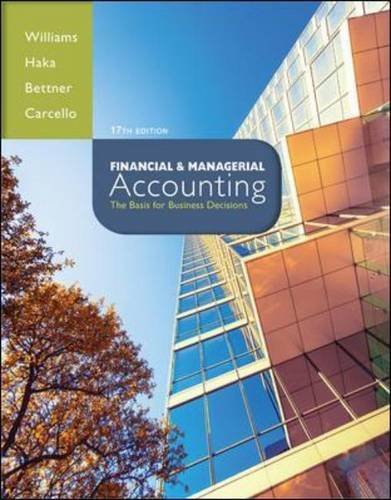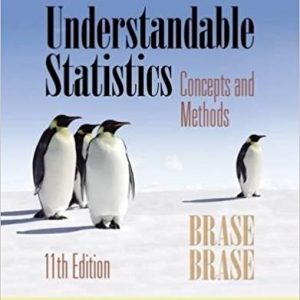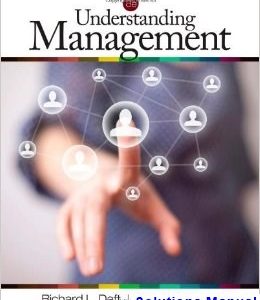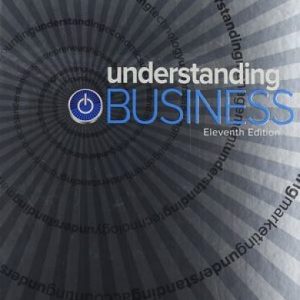This is completed downloadable of Solution manual for Financial and Managerial Accounting Williams Haka Bettner Carcello 17th edition

Product Details:
- ISBN-10 : 007802577X
- ISBN-13 : 978-0078025778
- Author:
With the seventeenth edition of Financial and Managerial Accounting: The Basis for Business Decisions, the Williams author team continues to be a solid foundation for students who are learning basic accounting concepts. Hallmarks of the text – including the solid Accounting Cycle Presentation, relevant pedagogy, and high quality, end-of-chapter material―have been updated throughout the book.
Table of Content:
- CHAPTER 1. ACCOUNTING: INFORMATION FOR DECISION MAKING
- Accounting Information: A Means to an End
- Accounting from a User’s Perspective
- Types of Accounting Information
- Accounting Systems
- Determining Information Needs
- The Cost of Producing Accounting Information
- Basic Functions of an Accounting System
- Who Designs and Installs Accounting Systems?
- Components of Internal Control
- Financial Accounting Information
- External Users of Accounting Information
- Objectives of External Financial Reporting
- Characteristics of Externally Reported Information
- Management Accounting Information
- Users of Internal Accounting Information
- Objectives of Management Accounting Information
- Characteristics of Management Accounting Information
- Integrity of Accounting Information
- Institutional Features
- Professional Organizations
- Competence, Judgment, and Ethical Behavior
- Careers in Accounting
- Public Accounting
- Management Accounting
- Governmental Accounting
- Accounting Education
- What about Bookkeeping?
- Accounting as a Stepping-Stone
- But What about Me? I’m Not an Accounting Major
- Ethics, Fraud, & Corporate Governance
- Concluding Remarks
- End-of-Chapter Review
- Assignment Material Discussion Questions
- CHAPTER 2. BASIC FINANCIAL STATEMENTS
- Introduction to Financial Statements
- A Starting Point: Statement of Financial Position
- Assets
- Liabilities
- Owners’ Equity
- The Accounting Equation
- The Effects of Business Transactions: An Illustration
- Effects of These Business Transactions on the Accounting Equation
- Income Statement
- Statement of Cash Flows
- Relationships among Financial Statements
- Financial Analysis and Decision Making
- Forms of Business Organization
- Sole Proprietorships
- Partnerships
- Corporations
- Reporting Ownership Equity in the Statement of Financial Position
- The Use of Financial Statements by External Parties
- The Need for Adequate Disclosure
- Management’s Interest in Financial Statements
- Ethics, Fraud, & Corporate Governance
- Concluding Remarks
- End-of-Chapter Review
- Assignment Material Discussion Questions
- CHAPTER 3. THE ACCOUNTING CYCLE: CAPTURING ECONOMIC EVENTS
- The Accounting Cycle
- The Role of Accounting Records
- The Ledger
- The Use of Accounts
- Debit and Credit Entries
- Double-Entry Accounting—The Equality of Debits and Credits
- The Journal
- Posting Journal Entries to the Ledger Accounts (and How to “Read” a Journal Entry)
- Recording Balance Sheet Transactions: An Illustration
- Ledger Accounts after Posting
- What Is Net Income?
- Retained Earnings
- The Income Statement: A Preview
- Revenue
- Expenses
- The Accrual Basis of Accounting
- Debit and Credit Rules for Revenue and Expenses
- Dividends
- Recording Income Statement Transactions: An Illustration
- The Journal
- February’s Ledger Balances
- The Trial Balance
- Uses and Limitations of the Trial Balance
- Concluding Remarks
- The Accounting Cycle in Perspective
- Ethics, Fraud, & Corporate Governance
- End-of-Chapter Review
- Assignment Material Discussion Questions
- CHAPTER 4. THE ACCOUNTING CYCLE: ACCRUALS AND DEFERRALS
- Adjusting Entries
- The Need for Adjusting Entries
- Types of Adjusting Entries
- Adjusting Entries and Timing Differences
- Characteristics of Adjusting Entries
- Year-End at Overnight Auto Service
- Converting Assets to Expenses
- The Concept of Depreciation
- Converting Liabilities to Revenue
- Accruing Unpaid Expenses
- Accruing Uncollected Revenue
- Accruing Income Taxes Expense: The Final Adjusting Entry
- Adjusting Entries and Accounting Principles
- The Concept of Materiality
- Effects of the Adjusting Entries
- Concluding Remarks
- Ethics, Fraud, & Corporate Governance
- End-of-Chapter Review
- Assignment Material Discussion Questions
- CHAPTER 5. THE ACCOUNTING CYCLE: REPORTING FINANCIAL RESULTS
- Preparing Financial Statements
- The Income Statement
- The Statement of Retained Earnings
- The Balance Sheet
- Relationships among the Financial Statements
- Drafting the Notes That Accompany Financial Statements
- What Types of Information Must Be Disclosed?
- Closing the Temporary Accounts
- Closing Entries for Revenue Accounts
- Closing Entries for Expense Accounts
- Closing the Income Summary Account
- Closing the Dividends Account
- Summary of the Closing Process
- After-Closing Trial Balance
- A Last Look at Overnight: Was 2015 a Good Year?
- Financial Analysis and Decision Making
- Preparing Financial Statements Covering Different Periods of Time
- Ethics, Fraud, & Corporate Governance
- Concluding Remarks
- Supplemental Topic: The Worksheet
- Isn’t This Really a Spreadsheet?
- How Is a Worksheet Used?
- The Mechanics: How It’s Done
- What If: A Special Application of Worksheet Software
- End-of-Chapter Review
- Assignment Material Discussion Questions
- COMPREHENSIVE PROBLEM 1: Susquehanna Equipment Rentals
- CHAPTER 6. MERCHANDISING ACTIVITIES
- Merchandising Companies
- The Operating Cycle of a Merchandising Company
- Income Statement of a Merchandising Company
- Accounting System Requirements for Merchandising Companies
- Two Approaches Used in Accounting for Merchandise Inventories
- Perpetual Inventory Systems
- Taking a Physical Inventory
- Closing Entries in a Perpetual Inventory System
- Periodic Inventory Systems
- Operation of a Periodic Inventory System
- Closing Process in a Periodic Inventory System
- Comparison of Perpetual and Periodic Inventory Systems
- Selecting an Inventory System
- Transactions Relating to Purchases
- Credit Terms and Cash Discounts
- Returns of Unsatisfactory Merchandise
- Transportation Costs on Purchases
- Transactions Relating to Sales
- Sales Returns and Allowances
- Sales Discounts
- Delivery Expenses
- Accounting for Sales Taxes
- Modifying an Accounting System
- Special Journals Provide Speed and Efficiency
- Financial Analysis and Decision Making
- Ethics, Fraud, & Corporate Governance
- Concluding Remarks
- End-of-Chapter Review
- Assignment Material Discussion Questions
- CHAPTER 7. FINANCIAL ASSETS
- How Much Cash Should a Business Have?
- The Valuation of Financial Assets
- Cash
- Reporting Cash in the Balance Sheet
- Cash Management
- Internal Control over Cash
- Bank Statements
- Reconciling the Bank Statement
- Short-Term Investments
- Accounting for Marketable Securities
- Purchase of Marketable Securities
- Recognition of Investment Revenue
- Sale of Investments
- Adjusting Marketable Securities to Market Value
- Accounts Receivable
- Internal Control over Receivables
- Uncollectible Accounts
- The Allowance for Doubtful Accounts
- Writing Off an Uncollectible Account Receivable
- Monthly Estimates of Credit Losses
- Recovery of an Account Receivable Previously Written Off
- Direct Write-Off Method
- Factoring Accounts Receivable
- Credit Card Sales
- Notes Receivable and Interest Revenue
- Nature of Interest
- Accounting for Notes Receivable
- Financial Analysis and Decision Making
- Ethics, Fraud, & Corporate Governance
- Concluding Remarks
- End-of-Chapter Review
- Assignment Material Discussion Questions
- CHAPTER 8. INVENTORIES AND THE COST OF GOODS SOLD
- Inventory Defined
- The Flow of Inventory Costs
- Which Unit Did We Sell?
- Data for an Illustration
- Specific Identification
- Cost Flow Assumptions
- Average-Cost Method
- First-In, First-Out Method
- Last-In, First-Out Method
- Evaluation of the Methods
- Do Inventory Methods Really Affect Performance?
- The Principle of Consistency
- Just-in-Time (JIT) Inventory Systems
- Taking a Physical Inventory
- Recording Shrinkage Losses
- LCM and Other Write-Downs of Inventory
- The Year-End Cutoff of Transactions
- Periodic Inventory Systems
- International Financial Reporting Standards
- Importance of an Accurate Valuation of Inventory
- Techniques for Estimating the Cost of Goods Sold and the Ending Inventory
- The Gross Profit Method
- The Retail Method
- “Textbook” Inventory Systems Can Be Modified … and They Often Are
- Financial Analysis and Decision Making
- Ethics, Fraud, & Corporate Governance
- Concluding Remarks
- End-of-Chapter Review
- Assignment Material Discussion Questions
- COMPREHENSIVE PROBLEM 2: Music-Is-Us, Inc.
- CHAPTER 9. PLANT AND INTANGIBLE ASSETS
- Plant Assets as a “Stream of Future Services”
- Major Categories of Plant Assets
- Accountable Events in the Lives of Plant Assets
- Acquisitions of Plant Assets
- Determining Cost: An Example
- Some Special Considerations
- Capital Expenditures and Revenue Expenditures
- Depreciation
- Allocating the Cost of Plant and Equipment over the Years of Use
- Causes of Depreciation
- Methods of Computing Depreciation
- The Straight-Line Method
- The Declining-Balance Method
- Which Depreciation Methods Do Most Businesses Use?
- Financial Statement Disclosures
- The Impairment of Plant Assets
- Other Depreciation Methods
- The Units-of-Output Method
- MACRS
- Sum-of-the-Years’ Digits
- Decelerated Depreciation Methods
- Depreciation Methods in Use: A Survey
- Disposal of Plant and Equipment
- Gains and Losses on the Disposal of Plant and Equipment
- Trading in Used Assets for New Ones
- International Financial Reporting Standards
- Intangible Assets
- Characteristics
- Operating Expenses versus Intangible Assets
- Amortization
- Goodwill
- Patents
- Trademarks and Trade Names
- Franchises
- Copyrights
- Other Intangibles and Deferred Charges
- Research and Development (R&D) Costs
- Financial Analysis and Decision Making
- Natural Resources
- Accounting for Natural Resources
- Depreciation, Amortization, and Depletion—A Common Goal
- Plant Transactions and the Statement of Cash Flows
- Ethics, Fraud, & Corporate Governance
- Concluding Remarks
- End-of-Chapter Review
- Assignment Material Discussion Questions
- CHAPTER 10. LIABILITIES
- The Nature of Liabilities
- Current Liabilities
- Accounts Payable
- Notes Payable
- The Current Portion of Long-Term Debt
- Accrued Liabilities
- Payroll Liabilities
- Unearned Revenue
- Long-Term Liabilities
- Maturing Obligations Intended to Be Refinanced
- Installment Notes Payable
- Bonds Payable
- What Are Bonds?
- Tax Advantage of Bond Financing
- Accounting for Bonds Payable
- Bonds Issued at a Discount or a Premium
- Accounting for a Bond Discount: An Illustration
- Accounting for a Bond Premium: An Illustration
- Bond Discount and Premium in Perspective
- The Concept of Present Value
- Bond Prices after Issuance
- Early Retirement of Bonds Payable
- Estimated Liabilities, Loss Contingencies, and Commitments
- Estimated Liabilities
- Loss Contingencies
- Commitments
- Evaluating the Safety of Creditors’ Claims
- Methods of Determining Creditworthiness
- How Much Debt Should a Business Have?
- Financial Analysis and Decision Making
- Ethics, Fraud, & Corporate Governance
- Special Types of Liabilities
- Lease Payment Obligations
- Operating Leases
- Capital Leases
- Liabilities for Pensions and Other Postretirement Benefits
- Deferred Income Taxes
- Concluding Remarks
- End-of-Chapter Review
- Assignment Material Discussion Questions
- CHAPTER 11. STOCKHOLDERS’ EQUITY: PAID-IN CAPITAL
- Corporations
- Why Businesses Incorporate
- Publicly Owned Corporations
- Formation of a Corporation
- Stockholder Records in a Corporation
- Paid-In Capital of a Corporation
- Authorization and Issuance of Capital Stock
- Common Stock and Preferred Stock
- Characteristics of Preferred Stock
- Book Value per Share of Common Stock
- Market Value
- Market Price of Preferred Stock
- Market Price of Common Stock
- Book Value and Market Price
- Stock Splits
- Treasury Stock
- Recording Purchases of Treasury Stock
- Reissuance of Treasury Stock
- Stock Buyback Programs
- Financial Analysis and Decision Making
- Ethics, Fraud, & Corporate Governance
- Concluding Remarks
- End-of-Chapter Review
- Assignment Material Discussion Questions
- COMPREHENSIVE PROBLEM 3: Springdale Retail, Inc.
- CHAPTER 12. INCOME AND CHANGES IN RETAINED EARNINGS
- Reporting the Results of Operations
- Developing Predictive Information
- Reporting Irregular Items: An Illustration
- Continuing Operations
- Discontinued Operations
- Extraordinary Items
- Earnings per Share (EPS)
- Financial Analysis and Decision Making
- Other Transactions Affecting Retained Earnings
- Cash Dividends
- Dividend Dates
- Liquidating Dividends
- Stock Dividends
- Statement of Retained Earnings
- Prior Period Adjustments
- Comprehensive Income
- Statement of Stockholders’ Equity
- Stockholders’ Equity Section of the Balance Sheet
- Ethics, Fraud, & Corporate Governance
- Concluding Remarks
- End-of-Chapter Review
- Assignment Material Discussion Questions
- CHAPTER 13. STATEMENT OF CASH FLOWS
- Statement of Cash Flows
- Purposes of the Statement
- Example of a Statement of Cash Flows
- Classification of Cash Flows
- Preparing a Statement of Cash Flows
- Operating Activities
- Investing Activities
- Financing Activities
- Cash and Cash Equivalents
- Cash Flows from Operating Activities
- Cash Payments for Merchandise and for Expenses
- Cash Flows from Investing Activities
- Cash Flows from Financing Activities
- Relationship between the Statement of Cash Flows and the Balance Sheet
- Reporting Operating Cash Flows by the Indirect Method
- Reconciling Net Income with Net Cash Flows
- The Indirect Method: A Summary
- Indirect Method May Be Required in a Supplementary Schedule
- The Statement of Cash Flows: A Second Look
- Financial Analysis and Decision Making
- Managing Cash Flows
- Budgeting: The Primary Cash Management Tool
- What Priority Should Managers Give to Increasing Net Cash Flows?
- Some Strategies for Permanent Improvements in Cash Flow
- Ethics, Fraud, & Corporate Governance
- A Worksheet for Preparing a Statement of Cash Flows
- Data for an Illustration
- The Worksheet
- Entry
- Concluding Remarks
- End-of-Chapter Review
- Assignment Material Discussion Questions
- CHAPTER 14. FINANCIAL STATEMENT ANALYSIS
- Financial Statements Are Designed for Analysis
- Tools of Analysis
- Dollar and Percentage Changes
- Trend Percentages
- Component Percentages
- Ratios
- Standards of Comparison
- Quality of Earnings
- Quality of Assets and the Relative Amount of Debt
- Measures of Liquidity and Credit Risk
- A Classified Balance Sheet
- Working Capital
- Current Ratio
- Quick Ratio
- Debt Ratio
- Evaluating Financial Ratios
- Liquidity, Credit Risk, and the Law
- Measures of Profitability
- Classifications in the Income Statement
- Multiple-Step Income Statements
- Earnings per Share
- Price-Earnings Ratio
- Single-Step Income Statements
- Evaluating the Adequacy of Net Income
- Return on Investment (ROI)
- Return on Assets (ROA)
- Return on Equity (ROE)
- Comprehensive Illustration: Seacliff Company
- Analysis by Common Stockholders
- Return on Investment (ROI)
- Leverage
- Analysis by Long-Term Creditors
- Analysis by Short-Term Creditors
- Cash Flow Analysis
- Usefulness of Notes to Financial Statements
- International Financial Reporting Standards
- Summary of Analytical Measurements
- Ethics, Fraud, & Corporate Governance
- Concluding Remarks
- End-of-Chapter Review
- Assignment Material Discussion Questions
- COMPREHENSIVE PROBLEM 4: Home Depot, Inc.
- CHAPTER 15. GLOBAL BUSINESS AND ACCOUNTING
- Globalization
- Environmental Forces Shaping Globalization
- Political and Legal Systems
- Economic Systems
- Culture
- Technology and Infrastructure
- Harmonization of Financial Reporting Standards
- International Financial Reporting Standards: Adoption or Convergence
- Foreign Currencies and Exchange Rates
- Exchange Rates
- Accounting for Transactions with Foreign Companies
- Currency Fluctuations—Who Wins and Who Loses?
- Consolidated Financial Statements That Include Foreign Subsidiaries
- Global Sourcing
- Foreign Corrupt Practices Act
- Ethics, Fraud, & Corporate Governance
- Concluding Remarks
- End-of-Chapter Review
- Assignment Material Discussion Questions
- CHAPTER 16. MANAGEMENT ACCOUNTING: A BUSINESS PARTNER
- Management Accounting: Basic Framework
- Management Accounting’s Role in Assigning Decision-Making Authority
- Management Accounting’s Role in Decision Making
- Management Accounting’s Role in Performance Evaluation and Rewards
- Accounting Systems: A Business Partner
- Accounting for Manufacturing Operations
- Classifications of Manufacturing Costs
- Product Costs versus Period Costs
- Ethics, Fraud, & Corporate Governance
- Product Costs and the Matching Principle
- Inventories of a Manufacturing Business
- The Flow of Costs Parallels the Flow of Physical Goods
- Accounting for Manufacturing Costs: An Illustration
- Direct Materials
- Direct Labor
- Manufacturing Overhead
- Direct and Indirect Manufacturing Costs
- Work in Process Inventory, Finished Goods Inventory, and the Cost of Goods Sold
- The Need for Per-Unit Cost Data
- Determining the Cost of Finished Goods Manufactured
- Financial Statements of a Manufacturing Company
- Concluding Remarks
- End-of-Chapter Review
- Assignment Material Discussion Questions
- CHAPTER 17. JOB ORDER COST SYSTEMS AND OVERHEAD ALLOCATIONS
- Cost Accounting Systems
- Job Order Cost Systems and the Creation of Goods and Services
- Overhead Application Rates
- What “Drives” Overhead Costs?
- Job Order Costing
- The Job Cost Sheet
- Flow of Costs in Job Costing: An Illustration
- Accounting for Direct Materials
- Accounting for Direct Labor Costs
- Accounting for Overhead Costs
- Accounting for Completed Jobs
- Job Order Costing in Service Industries
- Activity-Based Costing (ABC)
- ABC versus a Single Application Rate: A Comparison
- Stage 1: Separate Activity Cost Pools
- Stage 2: Allocate Activity Cost Pools to the Products
- Determining Unit Costs Using ABC
- The Trend toward More Informative Cost Accounting Systems
- Ethics, Fraud, & Corporate Governance
- Concluding Remarks
- End-of-Chapter Review
- Assignment Material Discussion Questions
- CHAPTER 18. PROCESS COSTING
- Production of Goods and Services and Costing Systems
- Process Costing
- Tracking the Physical Flow and Related Production Costs
- Process Costing and Equivalent Units
- Cost per Equivalent Unit
- Tracking Costs Using a Process Costing Production Report
- Evaluating Departmental Efficiency
- Ethics, Fraud, & Corporate Governance
- Concluding Remarks
- End-of-Chapter Review
- Assignment Material Discussion Questions
- CHAPTER 19. COSTING AND THE VALUE CHAIN
- The Value Chain
- International Financial Reporting Standards and the Value Chain
- Value- and Non-Value-Added Activities
- Activity-Based Management
- Activity-Based Management across the Value Chain
- ABC: A Subset of Activity-Based Management
- The Target Costing Process
- Components of the Target Costing Process
- Target Costing: An Illustration
- Characteristics of the Target Costing Process
- Just-in-Time Inventory Procedures
- JIT, Supplier Relationships, and Product Quality
- Measures of Efficiency in a JIT System
- Total Quality Management and the Value Chain
- Components of the Cost of Quality
- Measuring the Cost of Quality
- Productivity and Quality
- Ethics, Fraud, & Corporate Governance
- Concluding Remarks
- End-of-Chapter Review
- Assignment Material Discussion Questions
- CHAPTER 20. COST-VOLUME-PROFIT ANALYSIS
- Cost-Volume Relationships
- Fixed Costs (and Fixed Expenses)
- Cost-Volume Relationships: A Graphic Analysis
- The Behavior of Per-Unit Costs
- Economies of Scale
- Additional Cost Behavior Patterns
- Cost Behavior and Operating Income
- Cost-Volume-Profit Analysis: An Illustration
- Preparing and Using a Cost-Volume-Profit Graph
- Contribution Margin: A Key Relationship
- How Many Units Must We Sell?
- How Many Dollars in Sales Must We Generate?
- What Is Our Margin of Safety?
- What Change in Operating Income Do We Anticipate?
- Business Applications of CVP
- Additional Considerations in CVP
- CVP Analysis When a Company Sells Many Products
- Determining Semivariable Cost Elements: The High-Low Method
- Assumptions Underlying Cost-Volume-Profit Analysis
- Summary of Basic Cost-Volume-Profit Relationships
- Ethics, Fraud, & Corporate Governance
- Concluding Remarks
- End-of-Chapter Review
- Assignment Material Discussion Questions
- CHAPTER 21. INCREMENTAL ANALYSIS
- The Challenge of Changing Markets
- The Concept of Relevant Cost Information
- Relevant Information in Business Decisions
- International Financial Reporting Standards and Relevant Costs
- A Simple Illustration of Relevant Costs
- Opportunity Costs
- Sunk Costs versus Out-of-Pocket Costs
- Incremental Analysis in Common Business Decisions
- Special Order Decisions
- Production Constraint Decisions
- Make or Buy Decisions
- Sell, Scrap, or Rebuild Decisions
- Joint Product Decisions
- Ethics, Fraud, & Corporate Governance
- Concluding Remarks
- End-of-Chapter Review
- Assignment Material Discussion Questions
- COMPREHENSIVE PROBLEM 5: The Gilster Company
- CHAPTER 22. RESPONSIBILITY ACCOUNTING AND TRANSFER PRICING
- Responsibility Centers
- The Need for Information about Responsibility Center Performance
- Cost Centers, Profit Centers, and Investment Centers
- Responsibility Accounting Systems
- Responsibility Accounting: An Illustration
- Assigning Revenue and Costs to Responsibility Centers
- Variable Costs
- Contribution Margin
- Fixed Costs
- Traceable Fixed Costs
- Common Fixed Costs
- Responsibility Margin
- When Is a Responsibility Center “Unprofitable”?
- Evaluating Responsibility Center Managers
- Arguments against Allocating Common Fixed Costs to Business Centers
- Transfer Prices
- Nonfinancial Objectives and Information
- Ethics, Fraud, & Corporate Governance
- Responsibility Center Reporting in Financial Statements
- International Financial Reporting Standards and Responsibility Center Reporting
- Concluding Remarks
- End-of-Chapter Review
- Assignment Material Discussion Questions
- CHAPTER 23. OPERATIONAL BUDGETING
- Profit Rich, Yet Cash Poor
- Operating Cash Flows: The Lifeblood of Survival
- Budgeting: The Basis for Planning and Control
- Benefits Derived from Budgeting
- Establishing Budgeted Amounts
- The Budget Period
- The Master Budget: A Package of Related Budgets
- Steps in Preparing a Master Budget
- Preparing the Master Budget: An Illustration
- Operating Budget Estimates
- Budgeted Income Statement
- Cash Budget Estimates
- The Cash Budget
- Budgeted Balance Sheets
- Using Budgets Effectively
- Flexible Budgeting
- Ethics, Fraud, & Corporate Governance
- Concluding Remarks
- End-of-Chapter Review
- Assignment Material Discussion Questions
- CHAPTER 24. STANDARD COST SYSTEMS
- Standard Cost Systems
- Establishing and Revising Standard Costs
- Direct Materials Standards
- Direct Labor Standards
- Manufacturing Overhead Standards
- Standard Costs and Variance Analysis: An Illustration
- Materials Price and Quantity Variances
- Labor Rate and Efficiency Variances
- Manufacturing Overhead Variances
- Valuation of Finished Goods
- Evaluating Cost Variances from Different Perspectives
- A Final Note: JIT Systems and Variance Analysis
- Ethics, Fraud, & Corporate Governance
- Concluding Remarks
- End-of-Chapter Review
- Assignment Material Discussion Questions
- CHAPTER 25. REWARDING BUSINESS PERFORMANCE
- Motivation and Aligning Goals and Objectives
- Communicating Goals and Objectives
- Accounting Information and Feedback about Goal Achievement
- Rewarding Goal Achievement
- The DuPont System
- Return on Investment
- The Components of Return on Investment
- Return on Sales
- Capital Turnover
- Criticisms of ROI
- The Short Horizon Problem
- Failing to Undertake Profitable Investments
- Measurement Problems
- Residual Income and Economic Value Added
- Residual Income
- Economic Value Added
- The Balanced Scorecard
- The Financial Perspective
- The Customer Perspective
- The Business Process Perspective
- The Learning and Growth Perspective
- Difficulties with the Balanced Scorecard
- Management Compensation
- Components of Management Compensation
- International Financial Reporting Standards and Management Compensation
- Design Choices for Management Compensation
- Goals and Rewards in Life
- Ethics, Fraud, & Corporate Governance
- Concluding Remarks
- End-of-Chapter Review
- Assignment Material Discussion Questions
- COMPREHENSIVE PROBLEM 6: Utease Corporation
- CHAPTER 26. CAPITAL BUDGETING
- Capital Investment Decisions
- Financial and Nonfinancial Considerations
- Evaluating Capital Investment Proposals: An Illustration
- Payback Period
- Return on Average Investment
- Discounting Future Cash Flows
- Replacing Assets
- Behavioral Considerations in Capital Budgeting
- Concluding Remarks
- A Comment from the Authors
- Ethics, Fraud, & Corporate Governance
- End-of-Chapter Review
- Assignment Material Discussion Questions
- APPENDIX A. HOME DEPOT 2012 FINANCIAL STATEMENTS
- APPENDIX B. THE TIME VALUE OF MONEY: FUTURE AMOUNTS AND PRESENT VALUES
- The Concept
- Relationships between Present Values and Future Amounts
- Compound Interest
- Applications of the Time Value of Money Concept
- Future Amounts
- The Tables Approach
- The Future Amount of an Annuity
- Interest Periods of Less Than One Year
- Present Values
- Using Present Value Tables
- What Is the Appropriate Discount Rate?
- The Present Value of an Annuity
- Discount Periods of Less Than One Year
- Valuation of Financial Instruments
- Interest-Bearing Receivables and Payables
- “Non-Interest-Bearing” Notes
- Market Prices of Bonds
- Capital Leases
- Obligations for Postretirement Benefits
- Assignment Material Discussion Questions
- APPENDIX C. FORMS OF BUSINESS ORGANIZATION
- Importance of Business Form
- Sole Proprietorships
- The Concept of the Separate Business Entity
- Characteristics of a Sole Proprietorship
- Unlimited Personal Liability
- Accounting Practices of Sole Proprietorships
- Evaluating the Financial Statements of a Proprietorship
- Partnerships
- General Partnerships
- Partnerships That Limit Personal Liability
- Accounting Practices of Partnerships
- Evaluating the Financial Statements of a Partnership
- Corporations
- What Is a Corporation?
- Stockholders’ Liability for Debts of a Corporation
- What Types of Businesses Choose the Corporate Form of Organization?
- Accounting for Corporate Income Taxes
- Salaries Paid to Owners
- Owners’ Equity in a Corporate Balance Sheet
- The Issuance of Capital Stock
- Retained Earnings
- Accounting for Dividends
- Closing Entries and the Statement of Retained Earnings
- Evaluating the Financial Statements of a Corporation
- The Concept—and the Problem—of “Double Taxation”
- S Corporations
- Selecting an Appropriate Form of Business Organization
- Incorporating an Established Business
- Supplemental Topic: Partnership Accounting—A Closer Look
- Opening the Accounts of a New Partnership
- Allocating Partnership Net Income among the Partners
- Assignment Material Discussion Questions





